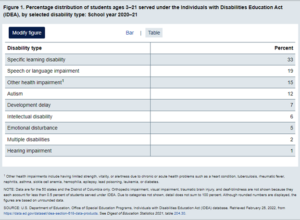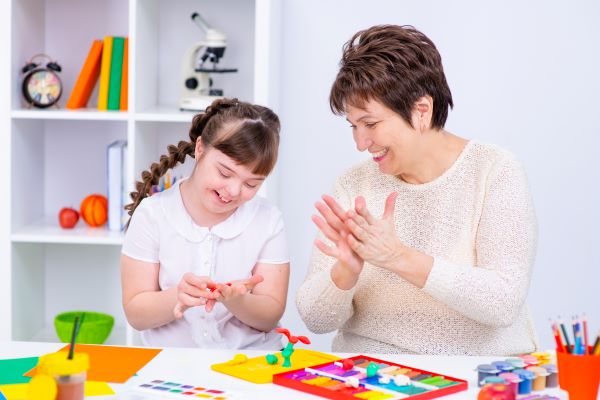According to statistics, there is approximately one special education teacher for every 17.1 students with learning disabilities in the US. Yet, in the past decade, the percentage of available and competent teachers fell by 17 percent. Many federal and state government educational programs address the needs of these children. Still, the student’s parents must become familiar with these programs to ensure their child receives the best public education available.

National Center for Education Statistics
The Individuals with Disabilities Act (IDEA)
The IDEA is a law making free public education available to eligible children with disabilities via federal and state programs nationwide. These programs ensure special education and its related services to those qualifying children. The IDEA stipulates how states and public agencies provide early intervention, special education, and other relevant services to more than 7.5 million (during the 2020-21 school year) qualifying infants, toddlers, children, and youth with disabilities.
The IDEA legislation establishes an important role for parents who want to participate in their children’s education. It provides a legal framework entitling a parent to treatment as an equal partner within their child’s school district, formulating an education plan to meet their child’s individual needs. Understanding what programs are available for your child’s educational needs makes a parent an informed and active advocate for their child’s legal rights and unique school program.
Free and Appropriate Public Education (FAPE)
All students, whether living with disabilities or not, have the same right to receive K-12 public education. For those students with special needs learning, the office for civil rights (OCR) through the US Department of Education works to ensure public elementary and secondary schools (including charter schools) provide FAPE benefits to all students with disabilities regardless of the nature or severity of their disabilities.
Providing appropriate education, modifications and aids, and related services free of charge comes under the ADA Section 504 and Title II legal requirements. Section 504 prohibits discrimination based on disability in an activity or program that receives federal funding. Title II prohibits discriminatory practices based on disability by public entities whether or not they receive federal financial assistance. In providing appropriate education, its design needs to meet the student’s educational needs as determined by evaluation processes and placement procedures.
Least Restrictive Environment (LRE)
The least restrictive environment is a legal term in IDEA law. A child with a disability is legally entitled to education within the same classroom as the typically mainstreamed student body who are not experiencing disability. LRE provides the greatest opportunity for a child with disabilities to interact and participate in the general student body and curriculum. This process is known as mainstreaming or inclusion.
There are different types of LRE, including:
- General education classroom with support options – The student spends all day in general education classes receiving support and services like a tutor or aide, assistive technology, modifications, accommodations, related services, or any combination.
- Partial mainstream/inclusion classroom – The student spends part of the day in general education classes and some individual or small-group special education instruction.
- Special education class – The student is in a program with other children with similar learning needs and receives specialized instruction.
- Specialized program outside of your school district – The student attends private school, residential programs, or hospital programs.
A parent must determine if LRE inclusion and what type is the most appropriate setting for their child. Some children benefit more fully in a special education program, a special needs school for children, or a home instruction program.
Early Intervention Services (EI)
Early intervention describes the supports and services available to families with babies and young children with disabilities and developmental delays. Typical services may include physical or speech therapy and other services that meet the child’s and family’s needs. Intervening before attending K-12 schools can significantly and positively impact a child’s ability to overcome challenges, learn new skills, and increase later successes in school and life.
To determine if your child is eligible for early intervention services at no cost, click here for your state’s process to evaluate your child’s skills and abilities to see if they qualify. A doctor’s referral is not necessary to determine eligibility though they are welcome to connect you with local programs. EI services vary widely among states and their regions. The document that outlines a child’s needs and services is the Individual Family Service Plan (IFSP) which reflects data from a comprehensive evaluation of the child.
Special Education Services
This service picks up where early intervention concludes at age three. The child’s local school district provides these services through its special education department — the focus shifts from EI developmental to Individualized Education Program (IEP) educational needs for the child.
The purpose of the IEP is to set reasonable learning goals for the student and outline the services the school district will provide to help the child meet these goals. Both key school staff and the child’s parents will develop the IEP based on present levels of functional performance and academic abilities, annual goals, and which special education and related services to provide to help achieve success for the student. IDEA requires students old enough to do so to participate in developing their IEP.
Extended School Year Services (ESY)
Evidence that a student will experience substantial regression in skills during summer break and school vacations may entitle them to ESY services. Not all students with IEPs are ESY-eligible, as the program varies by the school district and state services. Two common factors determining eligibility are regression and recoupment.
Regression means the student is at risk of losing knowledge and skills during school breaks. Recoupment is the projected timeline to re-acquire the knowledge and skills lost. The goal is to retain the student’s capabilities during school downtime rather than learning new skills. Some ESY services are via home-based activities that a parent or caregiver can oversee. Those eligible students requiring greater support may remain in school and receive full-time ESY services.
Technology Accessibility
The digital age creates new opportunities and increasing expectations for the full inclusion of students with special needs learning requirements. Assistive technology encompasses any item, equipment piece, or product system, whether commercial, off-the-shelf, customized, or modified, that can maintain, increase, or improve the functional capabilities of students with special needs learning.
By law, the lack of availability to cover the cost or lack of teachers with appropriate training is not an excuse for denying assistive technology devices. The child may take the device home if it benefits their education program, as concluded by the IEP team. A student’s IEP may list assistive technology requirements. Parents can challenge a school’s posture regarding their child and assistive technology.
The number of legal protections and rights safeguarding children with special educational needs becomes more robust each year. Parents may find it difficult to keep up with the changing educational environment and laws that govern schools and learning. Routine meetings with a special needs or disability attorney can assure your child with special needs is receiving the most support for their unique educational needs as possible.
We hope you found this article helpful. We help families build estate plans that work. Please contact our Coral Gables office today at (786) 804-3456 and schedule a consultation to discuss your legal matters. We look forward to the opportunity to work with you.

